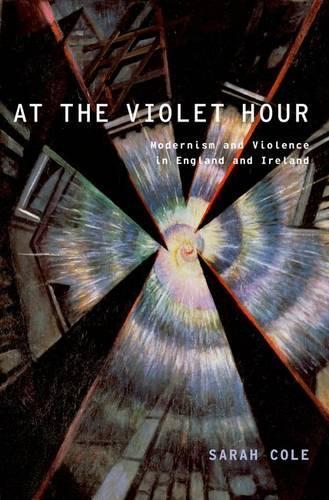Full Product Details
Author: Sarah Cole (Professor of English and Comparative Literature, Professor of English and Comparative Literature, Columbia University)
Publisher: Oxford University Press Inc
Imprint: Oxford University Press Inc
Dimensions:
Width: 23.60cm
, Height: 3.80cm
, Length: 15.50cm
Weight: 0.590kg
ISBN: 9780195389616
ISBN 10: 0195389611
Pages: 400
Publication Date: 29 November 2012
Audience:
College/higher education
,
Professional and scholarly
,
Tertiary & Higher Education
,
Professional & Vocational
Format: Hardback
Publisher's Status: Active
Availability: To order

Stock availability from the supplier is unknown. We will order it for you and ship this item to you once it is received by us.
Reviews
<br> At the Violet Hour persuasively outlines the intellectual culture of violence over the long turn of the century and powerfully demonstrates the imaginative motives and aesthetic consequences of the modernist immersion in it. Sarah Cole reveals the complexities of this literary engagement through readings equally subtle and bold, and in doing so she opens rich and compelling understandings of the historicity of modernist art. --Vincent Sherry, author of 6IThe Great War and the Language of Modernism<p><br> At the Violet Hour is a major contribution to modernist studies. It establishes the encounter with violence and bodily violation as the 'nerve center' of literary creation in a way that will make readers re-think the late nineteenth and early twentieth-century western canon. --Mark Hussey, editor of Virginia Woolf and War<p><br> Attentive to the variety as well as the centrality of violence's apparitions in literary modernism, this is at once a meticulous history, a groundbreaking taxonomy, and a voyage of reading in which one is fortunate to have a fearlessly subtle critic for one's guide. It's also a very beautiful and moving book. Cole everywhere keeps faith with the care for form that, as she shows, governed modernism's taking of greatness with violence. --Douglas Mao, author of Fateful Beauty<p><br>
Cole's well-written, formidably researched book is a treasure trove of incisive readings that will surely become a classic ... Highly recommended. * D. Stuber, CHOICE * At the Violet Hour is also striking in terms of what it leaves out: a full-scale exploration of the Great War, arguably the defining event in the concatenation of modernism and violence. * Paul Sheehan, Review of English Studies * Cole's close readings of violence in the work of some of the major modernists are superb. * Lauren Arrington, The Times Literary Supplement *
<br> At the Violet Hour persuasively outlines the intellectual culture of violence over the long turn of the century and powerfully demonstrates the imaginative motives and aesthetic consequences of the modernist immersion in it. Sarah Cole reveals the complexities of this literary engagement through readings equally subtle and bold, and in doing so she opens rich and compelling understandings of the historicity of modernist art. --Vincent Sherry, author of 6IThe Great War and the Language of Modernism<p><br> At the Violet Hour is a major contribution to modernist studies. It establishes the encounter with violence and bodily violation as the 'nerve center' of literary creation in a way that will make readers re-think the late nineteenth and early twentieth-century western canon. --Mark Hussey, editor of Virginia Woolf and War<p><br> Attentive to the variety as well as the centrality of violence's apparitions in literary modernism, this is at once a meticulous history, a groundbreaking taxonomy, and a voyage of reading in which one is fortunate to have a fearlessly subtle critic for one's guide. It's also a very beautiful and moving book. Cole everywhere keeps faith with the care for form that, as she shows, governed modernism's taking of greatness with violence. --Douglas Mao, author of Fateful Beauty<p><br> [A] magisterial study....Expansive, ambitious. --Woolf Studies Annual<p><br>
Cole's close readings of violence in the work of some of the major modernists are superb. Lauren Arrington, The Times Literary Supplement
Author Information
Sarah Cole is Professor of English and Comparative Literature at Columbia University and the author of Modernism, Male Friendship, and the First World War.




